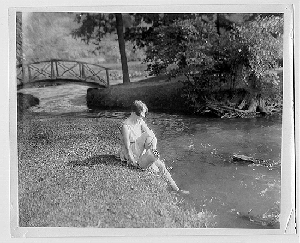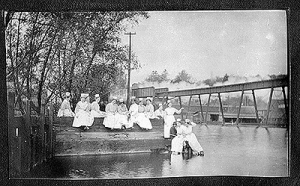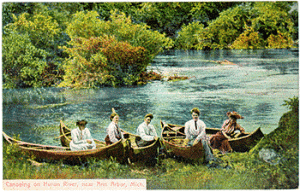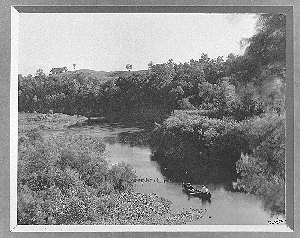University of Michigan Students have frequented the river as a favorite venue for contemplation, intimacy, or camaraderie. Their personal collections are filled with photographs, diaries, and letters alluding to the river. George Washington Pray, a student in the first graduating class of the university, mentions routinely in his diary his frequent walks through the woods of the Arboretum and along the river. In one entry from July 23, 1844 he wrote,
“In the evening I went walking with friend perry. We went through my favorite wood among the hills and valleys about 1 1/2 miles to a beautiful place by the river. On the high bank we could stand and look far off into the surrounding country. The sun was just setting and it gilded every thing around with its golden beams . Before us was the river winding along its shady banks with soothing murmurs and far off stretched scenery diversified with hills and woods with houses and fields all glittering in the setting sun. After enjoying this a little we went down to the banks of the river stripped and went in. After a good play in the water we slowly returned to the University enjoying the cool breezes of the lovely evening.”

Dancer by the Huron
Image from University of Michigan
Department of Education for Women Record Group
Alumnae Remember the River
In 1924, the University of Michigan Alumae Council undertook a survey of Michigan alumnae. Many of the hundreds of women who responded to the survey recalled the Huron River in response to the question on the last page of the form: “Won’t you add a few of the outstanding memories of your college days? We shall be glad to hear of any incident, however trivial, which lingers in your memory.”
 “The discovery that the best way to ‘cram’ for exams was to cram one’s mind full of the peacefulness of drifting down the Huron in canoe and twilight.”
“The discovery that the best way to ‘cram’ for exams was to cram one’s mind full of the peacefulness of drifting down the Huron in canoe and twilight.”
“Breakfast on the banks of the Huron, eaten between solemn & earnest statements dealing with such matters as the universe, human progress, socialism, religion, and philosophy.”
“Our good times would perhaps seem very insipid and tame to this generation, but we took lots of comfort going up the river canoeing in summer and skating above the dam in winter. The favorite hike was around the old boulevard. Sometimes a bunch of us would get up at 4 o’clock in the morning and watch the sun rise & the birds awakening along the river.”
” . . . a trip up the river in a canoe one June afternoon with a man friend. We talked to hobos along the railroad tracks and obtained some unusual glimpses into their lives. I paddled the entire distance. We each carried a gun and practiced shooting at marks, and before starting home gathered a boatload of water lilies.”
“The most memorable events are: 1. Escape from drowning in the Huron River in May 1896, when, according to the practice of those days, a group of students floated down, in flat bottom boats, from Ypsi to Rawsonville. As the river was in flood at that season, the trip was made with great speed but in constant danger of capsizing through the sharp stones and snags. We capsized!”
“At noon we went ashore and ate our lunch on the grass under some trees and the wild flowers were blooming all around us. After lunch three of us Medies took a small boat and went for a row. Anna sat in front and I at the back and our male escort rowed the boat. After we had rowed for some little time and splashed water on each other and thoroughly enjoyed ourselves we decided we would go ashore and go through the pulp mill. Anna’s end of the boat first came to shore, she said, “I will jump out and will pull the boat up on the shore,” out she jumped took hold of the rope and pulled the end of the boat up in the air while I and my end of the boat were submerged in the water. Our escort played the Hero and rescued me.”
[Quotations have been taken from the Alumnae Surveys of 1924 and 1927, which are included in the Alumni Association (University of Michigan) Record Group. ]
Ann Arbor Citizens and Visitors
Along with University of Michigan students, Ann Arbor citizens and visitors have created decades of documentation about their enjoyment of the Huron River.
Jasper Francis Cropsey drew an intimate sketch of the river during his visit to the area in 1855 (at left), at the same time when he was commisssioned by the University of Michigan Board of Regents to make two paintings of the university grounds and buildings. A well-regarded painter associated with the Hudson School of landscape painting, Cropsey was paid a total of $25.00 by the regents for his work in Ann Arbor.
The Boulevard, Cascade Glen, School Girls’ Glen, Lover’s Lane, and Picnic Island, were all familiar nameplaces for the Ann Arbor community. Judge Noah Cheever, who had first arrived in Ann Arbor as a student in 1859, printed a small pamphlet entitled Pleasant Walks and Drives About Ann Arbor. “Some of them will be rather long to designate as walks,” He forewarns, “but all who posses a bicycle or a horse or a horse and carriage, can readily enjoy the longest of them.” It was not unusual for casual walks to extend for miles, according to accounts left within diaries and letters.



